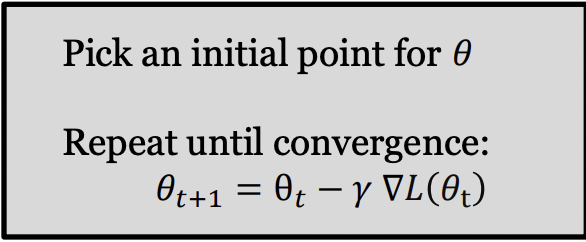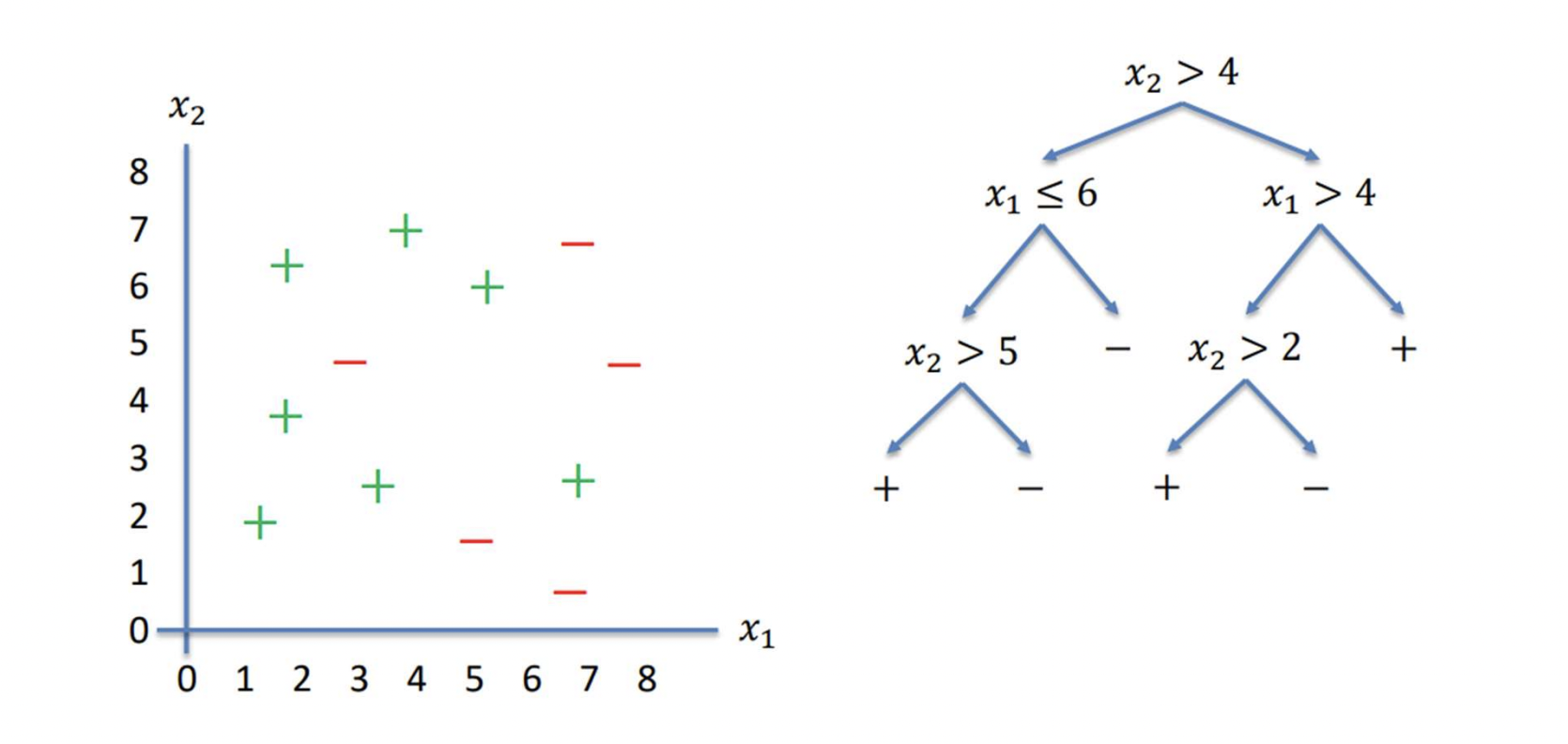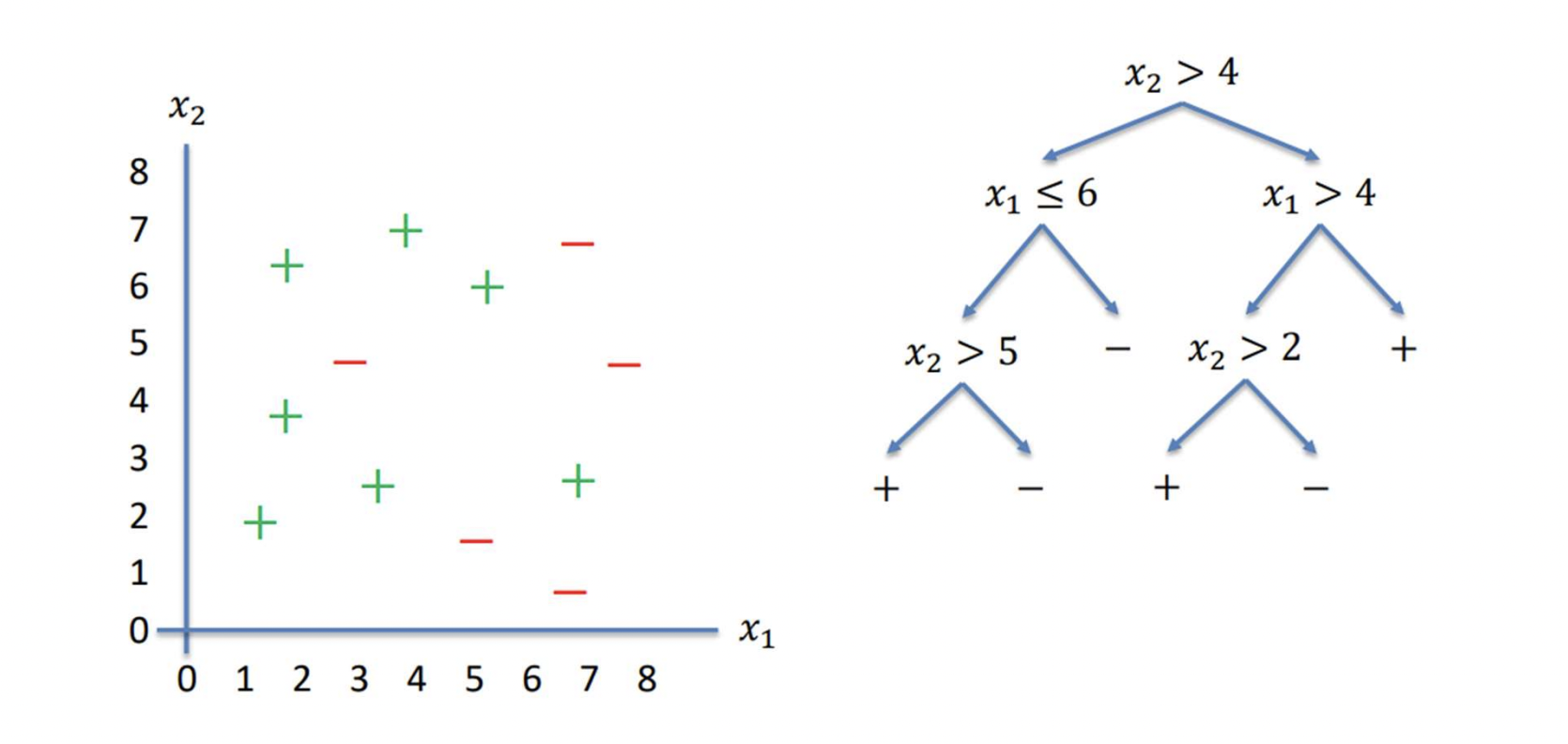intro to ml- regression & decision tree
1/59
Earn XP
Description and Tags
Name | Mastery | Learn | Test | Matching | Spaced |
|---|
No study sessions yet.
60 Terms
Supervised Learning- Input
(𝑥 (1) , 𝑦 (1) ), …, (𝑥 (𝑚) , 𝑦 (𝑚) ) where 𝑥 (𝑖) is the ith data point and 𝑦 (𝑖) is the ith label associated to this data point.
Supervised Learning- Want
find a function f such that 𝑓(𝑥(𝑖)) is a good approximation to 𝑦(𝑖)
Supervised Learning- Goal
Use function f to predict unseen data points x
Supervised learning- X
attributes, predictor variables, or independent variables
Supervised Learning- Y
classes, target variable, or dependent variable
concept to be learned
hypothesis space
set of functions f:X→Y
Classification
Learning how to separate/differentiate two or more classes (discrete or categorical target).
Learning the separating boundary
Classification Examples
Fraud/Not-Fraud, Spam/Not-Spam, Sentiment Analysis, Image Classification (fruits, cars, etc.)
Regression
Learning how to predict a continuous numerical target
Regression Examples
predicting temperature or house/stock prices
Linear Regression- Input
(𝑥 (1) , 𝑦 (1) ), …, (𝑥 (𝑚) , 𝑦 (𝑚) ) where 𝑥 (𝑖) ∈ ℝ and 𝑦 (𝑖) ∈ ℝ.
Linear Regression- Hypothesis Space
set of linear functions 𝑓 𝑥 = 𝑎𝑥 + b, where 𝑎 ∈ ℝ and 𝑏 ∈ ℝ
Linear Regression- Goal
find a function f such that 𝑓 𝑋 ≈ Y, minimizing the error metric
Linear Regression- Error
computed based on the difference between predicted and actual values

optimal linear hypothesis
minimizes squared differences between predicted value and actual value

Gradient Descent
iteratively change parameter 𝜃 until reaching the minimum value for 𝐿(𝜃)

Gradient
derivative at point

Gradient Descent Convergence
Gradient Descent will converge for convex functions, but the learning rate choice is crucial for that
Non-convex functions
can get stuck in a local minima
evaluate the learned hypothesis on
test data, not training data to avoid overfitting
Classification Input
(x(1), y(1)),..., (x(m), y(m)) where x(i)∈ℝ and y(i)∈ℤ
Classification
Want to learn a function f to predict a categorical or discrete target
What is decision tree?
It is a representation of concepts and hypothesis based on a set of Boolean/If-Then rules.The Boolean conditions will determine the outcomes.
Example of Decision Tree
(Outlook=“Sunny”) AND (Humidity=“Normal”) → Yes (you should play tennis)but,
(Outlook=“Sunny”) AND (Humidity=“High”) → No (you shouldn’t play tennis)
internal (non-leaf) node
tests the value of a particular feature (Outlook, Humidity, Wind)
leaf node
specifies a class label / outcome (in this case whether or not you should play tennis)
DT’s classify instances..
by sorting them down the tree from the root to some leaf node, which provides the classification of the instance
Each node in the tree...
specifies a test of some attribute of the instance
Each branch descending from that node
corresponds to one of the possible values for this attribute
Classification process
An instance is classified by starting at the root of the tree, testing the attribute specified by this node, then moving down the tree branch corresponding to the value of the attribute in the given example. This process is then repeated for the subtree rooted at the new node
Induction Process
Inferring general rules from specific data
Deductive Process
Using general rules to reach specific conclusions
Decision trees divide
the feature space into axis parallel rectangles

DT Algorithm
Recursive and Greedy Algorithm
Basic DT Algorithm
(i) Select an attribute
(ii) Split the data based on the values of this attribute (iii) Recurse over each new partition
How to decide which attribute?
Informally, we want that split that gives maximum purity at each node i.e., split such that all (or largest part of) instances belong to a single class
Entropy
Entropy measures the degree of disorder, impurity or randomness in the system.
It is equivalent to say that entropy measures the homogeneity of a decision tree node.
Entropy is maximized for uniform distributions
Entropy is minimized for distributions that place all their probability on a single outcome

for a binary random variable
Entropy is maximum at p=0.5, Entropy is zero at p=0 or p=1
Conditional Entropy
Conditional Entropy is the amount of information needed to quantify the random variable 𝑌given the random variable X. In practice, it tells you the uncertainty/impurity about a variable Y when another variable X is known

Information Gain
Informally, IG measures how good an attribute is for splitting heterogeneous group into homogeneous groups. Larger information gain corresponds to less uncertainty about 𝑌 given X

select an attribute..
with largest IG
Where to stop?
When the node is pure
When you run out of the attributes to recurse on
When there is no more data points in the node (empty)
The class corresponding to a leaf is determined by majority vote
Discretization
form an ordinal categorical attribute.
Equal interval bucketing
Equal frequency bucketing (percentiles)
Binary Decision (𝑥𝑘< 𝑡 or 𝑥𝑘 ≥ 𝑡)
consider all possible splits and find the best threshold t
More intensive computationally intensive, but do not need to test every threshold (just take the splits in between each consecutive pair of data points of same class)
The learning algorithm maximizes over all attributes and all possible thresholds of the real-valued attributes
Handling training examples with missing attribute values
Assign the most common values in the overall data
Assign the most common value based on other examples with same target value
Overfitting
On small datasets some splits may perfectly fit to the training data, but they won’t generalize well on unseen/unknown datasets
Sources of Overfitting
Noise, Small number of examples in leaves
DT model should generalize well
it should work well on examples which you have not seen before
Train / Test Split
Use training part to learn the model.
Use test to evaluate performance and validate the model.
Pre-pruning or Early Stopping
Stop the algorithm (recursion) before it generates a fully grown tree, or before it reaches a base case (pure or empty node)
Criteria to early stopping
Minimum number of samples in parents (before splitting)
Minimum number of samples on leaf nodes
Maximum depth of a tree
Minimum IG
Post Pruning
Grow full tree, then remove branches or nodes to improve the model’s ability to generalize
Reduced error pruning
remove branches that do not affect the performance on test/validation data
greedily remove one that improves validation set accuracy
Minimum impurity decrease
remove nodes if the decrease in impurity is lower that a given threshold
Handling attributes with high cardinality (many values)
penalize the attribute A by incorporating a term called “Split Information”
Split Information
sensitive to how broadly and uniformly the attribute splits the data
where 𝑝(𝑋) = 𝑥 corresponds to the proportion of the data such that value x is assigned to attribute X.

Gain Ratio
use instead of IG

binary tree properties
A complete binary tree of height h has 2h+1 -1 nodes
Number of nodes at depth d is 2d
Decision Tree Properties
Due to the complexity inherent to decision tree structures, it usually overfits (pruning is always a good idea)
Simple models that explain the data are usually preferred over more complicated ones
Finding the small tree that explains the concept to be learned as good as a larger one is known to be an NP-hard problem
Greedy heuristic: pick the best attribute (highest IG) at each stage
Common DT methods
ID3 (Iterative Dichotomiser 3)
CART (Classification And Regression Trees)
C4.5 (improvements over ID3)
CHAID (Chi Squared Automatic Interaction Detection)